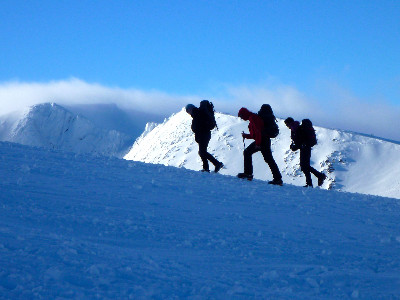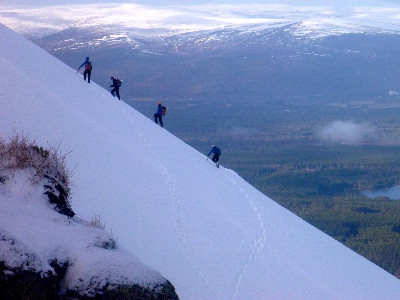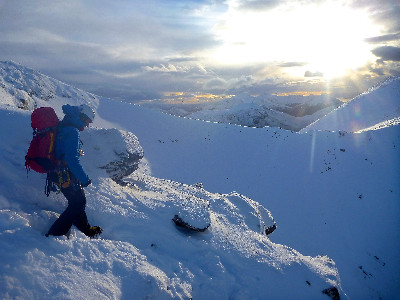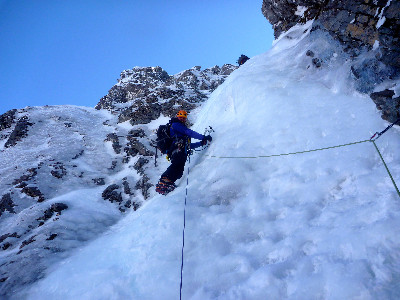by Al Halewood MIC IML
What does this Instructor keep in his sack in the winter, and more importantly why?
When the days shorten and the snow (hopefully) falls my rucksack gets that bit heavier than in summer. Here is a look at the contents and why I choose these things to take.

I canít be bothered trying to cram things into a small bag and I dislike having things dangling on the outside in case they get snagged or damaged so a decent size bag of about 40 litres suits me for most winter needs. Add a hip belt and chest strap and some side compression straps for stowing an ice axe. I like a lid with a pocket for smaller essentials but otherwise as few frills as possible.
At the bottom of the bag lies my emergency kit. An Ďessentialsí first aid kit (triple waterproofed and regularly checked and restocked). A group shelter of the appropriate size. A sealed plastic packet containing a blizzard bag and a couple of shake and warm type heat packs.
Next up is another waterproof stuffsack and inside is a large artificial fill insulated jacket (what climbers call a belay jacket). I live in the West HighlandsÖ Iím aware of the concept of hydrophobic down but it has yet to reach a quality where it will resist our wet climate. In each pocket of this jacket are a spare hat and buff on one side and a pair of mitts. There is usually a little spare food in the chest pocket too.
Down inside the back of the rucksack is a small scrap of foam mat, either an offcut from a larger one or a purpose bought sit mat.
A shovel. I have an Ortovox Beast 2.0. Itís well named. When presented firmly to anything short of water ice the sharp blade makes an instant impression, unlike some lighter shovels. The shaft comes off and it and the blade slide nicely down the corner and back of my bag.
The above represents my standard emergency kit carried on walks of anything but the shortest duration or lowest elevation. I know that, in the event of a problem, a night out whilst not comfortable will be highly survivable with this kit.
A mid layer in yet another waterproof stuffsack and a pair of medium to heavyweight gloves. These are for when Iíve passed the initial walk in and I may be moving slower on more technical ground or just have gotten higher and be out in more exposed conditions.
Crampons. I use my kit a lot in the winter and find a clip on crampon with flat frontpoints like the Grivel G12 with a clip on binding suits me for most walking and mountaineering. These will be sized to fit appropriate boots.
Helmet? If Iím going to be mountaineering or on ground where anything could fall in my direction, this is kept initially dome up just under the lid of my sack. Sometimes if my lunch is of a fragile nature itís inside this too.
My phone. With electronic mapping. In multiple layers of waterproofing. Usually turned off and on longer journeys with a small spare charger and cable. My map and compass tend to live in my jacket pockets.
Food and drink. I have a couple of insulated mugs which I usually have hot blackcurrant in totalling about 700ml of warm fluid and I find it easier to use one at a time leaving the other hot until later. Food: Iím trying to reduce how much chocolate I eat on the hill and to use more effective foods like dried fruit and nuts, oat based cereal bars for a more steady energy supply but there will be a treat or two in there somewhere.
Another waterproof bag. If I donít expect to use it early on, a buff if itís particularly foul and another pair of gloves (I like the leather fleecy lined waterproofed and reinforced black sheep gloves by Snowshepherd.) I also keep a pair of thin nitrile gloves handy in here in case of first aid incidents.
Headtorch: I tend not to carry spare batteries but if walking solo or in a small group or when going a long way from the road Iíll carry a spare torch like a Petzl Elite.
Goggles: A clear pair in a hard case to protect them. A winter essential in all but the most benign weather.
Sunglasses: Also in a hard case for those rare days when the sunblock is also carried!

The endless debatesÖ how long and how lightÖ straight shaft or ergonomic? As in all things there are pros and cons.
A longer axe is of more use for balance especially on easier angled terrain. However it can be more awkward to learn to self-arrest with and close to useless on steeper mountaineering ground. A short axe is only useful for balance on steeper ground unless you plan to walk hunched over but comes into its own when the angle kicks up. Lightweight ski touring axes are nice in terms of the load carried but Iíve found them far less effective for digging with, cutting steps (even with crampons on I spend much of my winter day digging and chopping different shaped holes and ledges) or even self-arrest in firmer snow.
I have both ergonomic and straight shafted walking/mountaineering axes and rarely notice a difference but I do like a decent sixed adze for chopping.
Walking poles. One or two as you like. These are an essential for me in deep snow and on flatter rough terrain. However I make a clear distinction about when to change to an axe. If there is any chance of a slip turning into a slide at all then the axe takes prime position in my hands.

A warm layering system, light midlayer over a thermal top. A waterproof jacket with a hood that goes over my helmet and face at the same time. I often add longer cords wrapped in tape to zips for easier operation in gloves. Likewise waterproof trousers. Watch out for skiing trousers that are baggy at the ankle these can cause a trip with crampons. A ĺ or full length zip is a winter essential for ease of donning and removal over big boots. I wear mine over a warm softshell pant. Some people prefer powerstretch type leggings but Iíd rather not inflict that sight on the world! A beanie or sometimes peaked cap and possibly a buff around my neck. On my hands my lighter Ďwalk iní gloves. These usually last until crampons go on. I can do that job wearing them but they will often be wet by then so I change gloves afterwards unless itís really nice. I wear silk inners whenever possible. It is so much easier to change gloves over slightly damp silk inners than to feel fleece sticking to wet hands and to struggle to get your next pair of gloves on properly.
My map and compass will be filed away in their usual pockets and my camera.
Boots. Stiff. Warm. With a heavy duty sole that will show the snow who is boss. The boots for winter need to be beefy enough to keep you warm in calf deep damp snow all day and to have a sole that looks like it has a blocky sawtooth profile to help me kick steps in firmer snow. I often wear gaiters in deeper snow. I wear them over my boots but under my waterproof trousers.
On particularly foul days Iíll have more gloves or when Iím expecting to dig a lot. I can recommend Polyco thermal lined chemical resistant Ďrubberí gloves (bought large to fit over my silk liners) for those very wet days in the snow.
The above is based on my own preferences and prejudices born of my own experience. As a Mountaineering Instructor, Iím often alternating between working hard, moving, and stopping to teach or point things out to those Iím with. I also tend to carry a good suite of emergency equipment to take care of all of us. Try things out and discover what works for you but be critical when reviewing how your equipment and systems have performed at the end of winter days, especially the tough ones!

Al Halewood runs his own business, Climb When Youíre Ready - www.climbwhenyoureready.com - based in Corpach, near Fort William, and guiding and teaching walking, climbing and mountaineering in summer and winter conditions in the UK.
He holds the Mountaineering Instructor Certificate, the UK based qualification for instructing and guiding all aspects of walking, climbing and mountaineering in summer and winter in the UK. He has also worked overseas and holds the International Mountain Leader Award.
Association of Mountaineering Instructors (AMI)
The Association of Mountaineering Instructors is the representative body for professionally qualified Mountaineering Instructors in the UK and Ireland. AMI members are highly experienced mountaineers who have undergone rigorous training and assessment to qualify under the Mountain Training UK (MTUK) Mountaineering Instructor scheme. AMI is committed to promoting good practice in all mountaineering instruction. By employing an AMI member you will be in the very best of hands. Look for the AMI logo as assurance of high quality instruction. www.ami.org.uk